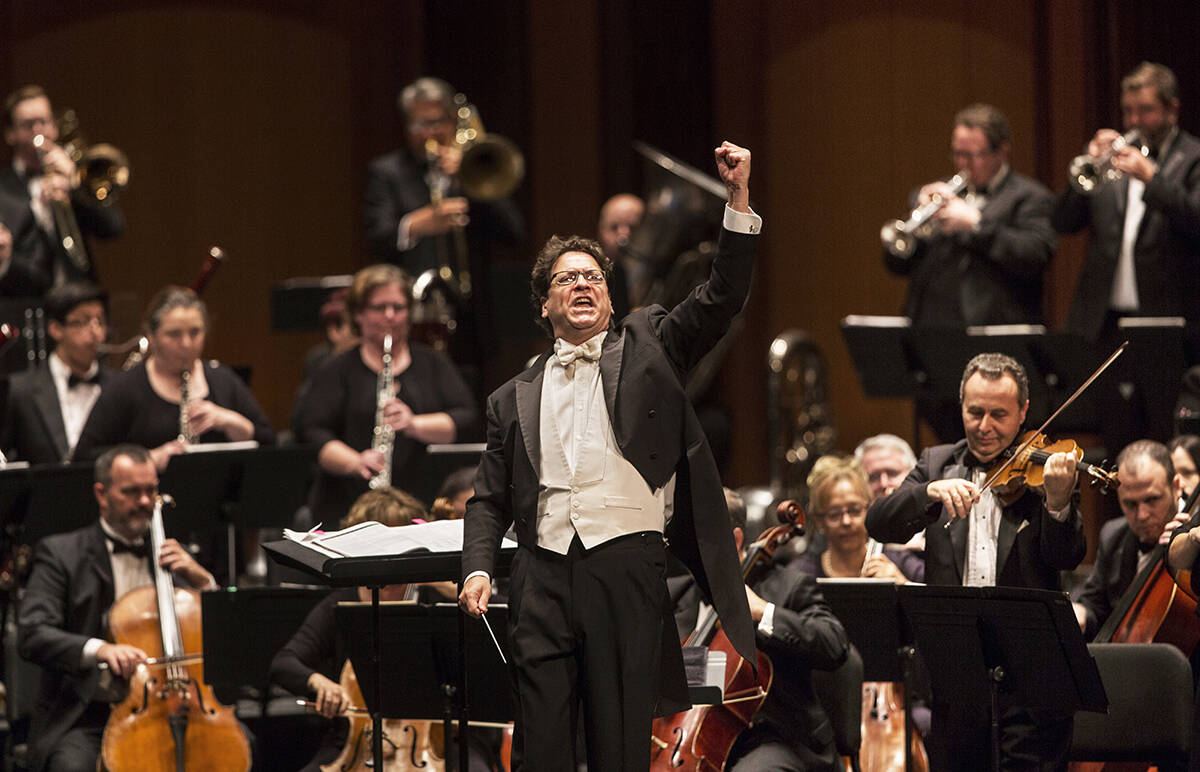Philharmonic goes with great composers, and Bugs Bunny, in new season
Donato Cabrera bridges the artistic chasm between Beethoven and Bugs Bunny.
“When I think of ‘Bugs Bunny at the Symphony,’ I think of the fact that those cartoons are what got me interested in classical music, before I even knew that there was such a thing as classical music,” the Las Vegas Philharmonic’s music director says. “I think most Americans, for many generations, they see Bugs Bunny rubbing the scalp of Elmer Fudd to ‘The Barber of Seville’ overture and they don’t even know that it’s a classical piece of music.”
The Jan. 7 return to the music layered into those great Warner Bros. cartoons, “Bugs Bunny at the Symphony,” is just one slice of the nine-piece pie that is the 2022-23 Las Vegas Philharmonic season. The symphony’s series premieres at 7:30 p.m. Sept. 17 with “American Classics.” The showcase celebrates a quartet of American composers: William Grant Still (“Festive Overture”), George Antheil (“Hot-Time Dance”), Wynton Marsalis (Violin Concerto in D) and Ferde Grofé (“Grand Canyon” suite).
Another celebration of American composers, “Appalachian Spring,” featuring the string trio Time for Three, follows on Oct. 15. Artist-in-residence Joshua Roman, an inspiring and inventive cellist, will be featured in “Cabrera Conducts Elgar &Sibelius” on Nov. 19.
Further highlights include “Handel’s Messiah” (Dec. 3),” “Cabrera Conducts Saint-Georges, Chopin and Mozart” (Feb. 11), “The Music of John Williams” (March 4), “A Night at the Opera” (April 1), and the season-closing “Cabrera Conducts Tchaikovsky” (May 6).”
Since he was appointed as the Philharmonic’s music director in 2014, Cabrera has advanced familiarity and adventurism in his selections each season. That’s why we see Bugs, and the celebration of John Williams’ soaring scores (with “Jaws,” “Superman,” “Star Wars” and “Harry Potter and the Sorcerer’s Stone” in the program), and especially the first two performances of the season.
“The music that I chose is a reflection of who we are, and who we would like to be, institutionally and artistically,” Cabrera says. “Going forward, there’s a definite leaning into American music, and that’s totally reflected in the first two concerts, by design. ‘Rhapsody in Blue’ is played all the time, ‘American in Paris is played, and “ ‘West Side Story’ is, too.
“They are staples of what could be considered American symphonic tradition, but there is so much more music out there.”
After 2021-22’s Beethoven-heavy slate, the idea is to present a season that allows the Philharmonic to recover from its COVID-19 pause.
“Like all arts organizations, the Philharmonic is still finding its way back,” Cabrera says. “The music that was chosen last year, with trying to submit all of Beethoven’s symphonies in one season, as well as something by a living American composer, was a great statement.”
That message continues through 2023, as Cabrera and the symphony try to reconcile artistic merit with making money.
“It’s an interesting question, how we make that balance. But I don’t think of the ticket sales and marketing first,” Cabrera says. “We want to bring the best shows. Look at something like the John Williams concert, which of course serves the marketing and ticket sales needs. But so many classical musicians think of John Williams as the greatest living American composer, period, for everything he has done. So, I look at it from that angle, and it works for us.”
John Katsilometes’ column runs daily in the A section. His “PodKats!” podcast can be found at reviewjournal.com/podcasts. Contact him at jkatsilometes@reviewjournal.com. Follow @johnnykats on Twitter, @JohnnyKats1 on Instagram.
The 2022-2023 Las Vegas Philharmonic Season
Where: Reynolds Hall at Smith Center for the Performing Arts.
Tickets: Patron services at 702-462-2008, or visit lvphil.org or thesmithcenter.com.
**
Saturday, September 17, 2022 at 7:30PM
Title: CABRERA CONDUCTS AMERICAN CLASSICS
DONATO CABRERA, conductor
KELLY HALL TOMPKINS, violin
WILLIAM GRANT STILL Festive Overture
WYNTON MARSALIS Concerto in D Major for Violin and Orchestra
GEORGE ANTHEIL Hot-time Dance
FERDE GROFÉ Grand Canyon Suite
The spirit and beauty of our Land of Liberty are captured in these selections by four American composers who shaped the classical tradition from Still's uplifting Festive Overture and Antheil's musical circus in Hot-Time Dance to Marsalis's sweeping melodies in his Violin Concerto in D and Grofe's masterful depiction of the Southwest in his Grand Canyon Suite.
***
Saturday, October 15, 2022 at 7:30PM
Title: CABRERA CONDUCTS APPALACHIAN SPRING
DONATO CABRERA, conductor
TIME FOR THREE
NICOLAS KENDALL, violin
CHARLES YANG,violin
RANAAN MEYER, double bass
SAMUEL BARBER Essay No.2, Op.17
JENNIFER HIGDON Concerto 4-3
VIRGIL THOMSON The Plow That Broke the Plains Suite
AARON COPLAND Appalachian Spring Suite
Bluegrass, folk and hymn-like melodies represent the sounds of a vast American landscape in this beautifully crafted program. Hear Barber's popular one movement orchestral work titled Essay No. 2, followed by Higdon's Smoky Mountains inspired Concerto 4-3 filled with offbeats, open strings and slides. The orchestra continues through the High Plains in Thomson's film score, The Plow That Broke the Plains Suite and finishes the American tour with Copland's inspirational Appalachian Spring Suite.
***
Saturday, November 19, 2022 at 7:30PM
Title: CABRERA CONDUCTS ELGAR & SIBELIUS
DONATO CABRERA, conductor
JOSHUA ROMAN, cello
SAMUEL COLERIDGE-TAYLOR The Bamboula, Op.75 (Rhapsodic Dance No.1) EDWARD ELGAR Cello Concerto in E Minor, Op. 85
JEAN SIBELIUS Symphony No. 2
The orchestra presents a masterful blend of heritage, sentiment and texture starting with Coleridge-Taylor's spirited 18th century Haitian dance, The Bamboula, followed by Elgar's beloved Cello Concerto in E Minor featuring artist-in-residence Joshua Roman and ending with the voice of Finland, Sibelius's bold and triumphant Symphony No. 2.
***
Saturday, December 3, 2022 at 7:30PM
Title: HANDEL'S MESSIAH
DONATO CABRERA, conductor
KATRINA GALKA, soprano
HANNAH LUDWIG, mezzo
RICARDO GARCIA, tenor
Efrain Solis, bass
GEORGE FRIDERIC HANDEL Messiah
Choral and orchestral hearts unite in Handel's most famous oratorio, Messiah. Your symphony orchestra is joined by local chorus and four powerful soloists. Behold the resplendent beauty of this spiritually uplifting work, which has become a musical rite of the holiday season.
***
Saturday, January 7, 2023 at 7:30PM
Title: WARNER BROS. PRESENTS BUGS BUNNY AT THE SYMPHONY
GEORGE DAUGHERTY,conductor/producer/arranger
Created by GEORGE DAUGHERTY and DAVID KA LIK WONG
"What's Up, Doc?" A brilliantly blend of classical music and classic animation! Bugs Bunny At The Symphony has toured the world, and now makes its Las Vegas premiere with The Las Vegas Philharmonic. The world's most iconic Looney Tunes — What's Opera, Doc?, The Rabbit of Seville, Corny Concerto, and more than a dozen others— will be projected on the big screen, while their exhilarating original scores are played live by the orchestra. This iconic concert spotlights beloved favorites as well as five brand-new animated shorts, and their classically-infused music. Conducted by George Daugherty. Created by George Daugherty & David Ka Lik Wong.
TM & © Warner Bros. Entertainment Inc. (s22)
This concert underwritten by George Daugherty and David Ka Lik Wong
***
Saturday, February 11, 2023 at 7:30PM
Title: CABRERA CONDUCTS SAINT-GEORGES, CHOPIN AND MOZART
DONATO CABRERA, conductor
MARIA RADUTU, piano
JOSEPH BOLOGNE, CHEVALIER DE SAINT-GEORGES Symphony No. 2 in D Major, Op. 11 (The Anonymous Lover)
WOLFGANG AMADEUS MOZART Symphony No. 31 in D Major (Paris Symphony)
FRÉDÉRIC CHOPIN Piano Concerto No.1 in E Minor, Op. 11
Elegance, lyricism, and form are explored in these brilliant works by Saint-Georges, Mozart and Chopin. Saint-Georges enchants audiences with his comedic opera, "The Anonymous Lover," and Mozart captures the essence of Parisian musical taste in his Symphony No. 31. For the finale, Chopin demonstrates his mastery of the piano in his exquisite Piano Concerto No. 1 featuring renowned pianist Maria Radutu.
***
Saturday, March 4, 2023 at 7:30PM Title: THE MUSIC OF JOHN WILLIAMS
DONATO CABRERA, conductor
Olympic Fanfare and Theme
Suite from Jaws
Superman March from Superman
Harry's Wondrous World from Harry Potter and the Sorcerer's Stone
Theme from Schindler's List
Adventures on Earth from E.T. Princess Leia's Theme from Star Wars Suite
And More!
Feel the force when the Music of John Williams returns to Las Vegas! Your symphony orchestra performs popular soundtracks from America's favorite movie blockbusters including the Suite from Jaws, Superman's March, Harry's Wondrous World, Adventures on Earth from E.T., Princess Leia's Theme, Parade of the Ewoks, Main Title from Star Wars Suite plus many more exciting musical gems!
***
Saturday, April 1, 2023 at 7:30PM
Title: A NIGHT AT THE OPERA
DONATO CABRERA, conductor
Selections from the following composers:
WOLFGANG AMADEUS MOZART GAETANO DONIZETTI LÉO DELIBES GEORGES BIZET PIETRO MASCAGNI GIACOMO PUCCINI JOHN ADAMS GIUSEPPE VERDI
Indulge in an evening of passion, betrayal, sacrifice, and bittersweet farewell as your symphony orchestra performs arias from the world's most famous operas. Four distinguished opera stars are joined on stage by local chorus for a powerhouse performance featuring selections from Carmen, Cosí fan tutte, Doctor Atomic, Don Giovanni, La bohème, La Traviata, The Marriage of Figaro, Rigoletto and more!
***
Saturday, May 6, 2023 – 7:30PM
Title: CABRERA CONDUCTS TCHAIKOVSKY
DONATO CABRERA, conductor
ILYA YAKUSHEV, piano
JEAN SIBELIUS Finlandia, Op. 26
SERGEI PROKOFIEV Piano Concerto No. 3 in C Major, Op. 26
PYOTR ILYICH TCHAIKOVSKY Symphony No. 4 in F Minor, Op. 36
For the grand finale, the Las Vegas Philharmonic presents three prominent works starting with Sibelius's patriotic tone poem, Finlandia, and Prokofiev's virtuosic Piano Concerto No. 3 featuring the lightning speed dexterity of pianist Ilya Yakushev. To close our 24th season, the orchestra performs Tchaikovsky's Symphony No. 4, a turbulent tour de force of fate.



















